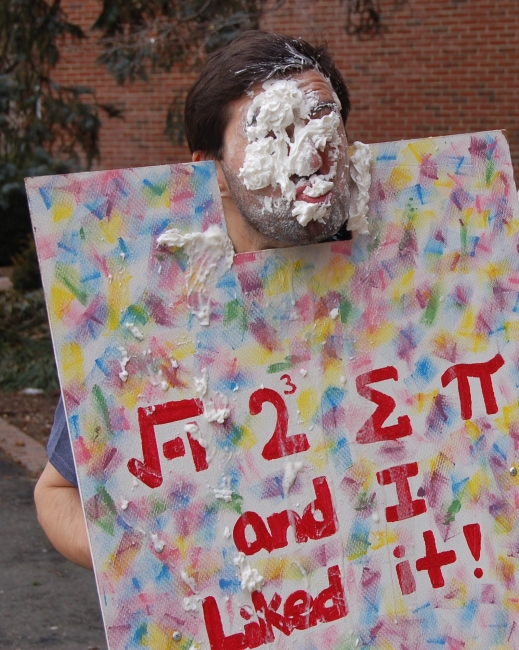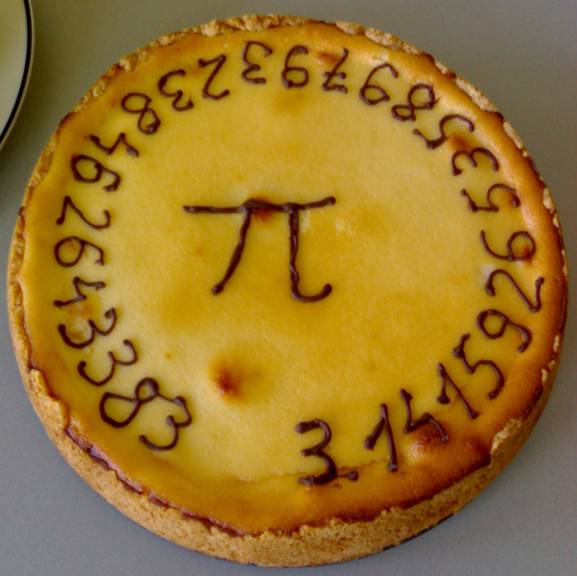You have /5 articles left.
Sign up for a free account or log in.

With a sign that reads, "I ate some pi and I liked it!" a volunteer at Adelphi University sports a face full of whipped cream Wednesday at a Math and Computer Science Club event.
Photo courtesy of Michael Nicholas
Math’s annual day in the headlines is approaching, and this year, the spotlight is extra exact. That’s because Saturday is the most accurate Pi Day of the entire 21st century.
Pi Day is celebrated every March 14 in honor of the mathematical constant pi. The number, which rounds to 3.14, represents the ratio of a circle’s circumference to its diameter.
With pies and puns a plenty, Pi Day has grown beyond its beginnings as a geek holiday into one of math’s more recognizable public celebrations.
This year, the calendar date aligns with two additional digits of pi, 3.1415. That won't happen again until March 14, 2115. On college campuses, math and science student groups are using the historical significance as a marketing tool to draw crowds to annual Pi Day festivities.
The most popular activities include pie-eating contests, recitation competitions and raffles to pie a professor. The promise of free pie also attracts students to lectures about pi and the importance of math in daily life.
On many campuses, the events also serve as a fund-raising opportunity for student groups. That's the case at Villanova University, where the math club plans to sell pies to benefit a nonprofit organization in Ecuador.
In Oregon, Clatsop Community College’s annual event usually draws around 200 people, both college students and local families. This year, organizers are expecting at least that number to participate in pi-themed art making, trivia and games. A band named the π’d π’pers will play semioriginal songs including “I Will Survive Math Class,” sung to the tune of Gloria Gaynor’s hit, and “Mathematical Pi,” set to the tune of Don McLean’s classic.
At the University of Georgia, Pi Day falls during spring break, so there aren’t any campus activities planned. But one recent graduate of the school’s mathematics and science education program is honoring the day with her family, friends and soon-to-be husband. Jenny Johnson planned her wedding for 9:26 a.m., with a reception from 5:35 p.m. to 8 p.m. and dancing until 9 p.m., according to the college’s news service. (In case you lost count, that’s 12 digits of pi after the decimal.)
At Rose-Hulman Institute of Technology in Indiana, Pi Day means chalking the transcendental number on sidewalks around campus.
The Mathematical Association of America said it supports Pi Day's efforts to broaden public appreciation for math. But pi is not the only constant in mathematics, nor is it the only important number for mathematicians.
“We’d hate to be seen as playing favorites,” Executive Director Michael Pearson said.
 What is it, then, about this one number that causes such interest that professors volunteer for a face full of whipped cream?
What is it, then, about this one number that causes such interest that professors volunteer for a face full of whipped cream?
In part, our fascination with mystery, mathematicians say. The full value of pi can never be known. And while a circle is such a simple shape, pi is irrational, meaning its decimals never repeat and they never end.
For physicist Carolyn Sealfon, pi is amazing because it’s so ubiquitous in mathematical models that describe nature. Sealfon is the associate director of science education on the Council on Science and Technology at Princeton University.
“The beauty and predictive power of science rests on people’s ability to uncover testable patterns in nature, and pi’s preponderance points to such patterns,” she said in an e-mail.
Sealfon and her colleague on the science and technology council, Aatish Bhatia, are giving a demonstration Saturday about all the physical phenomena that are modeled with equations involving pi, such as waves and gravitational forces. The demo is one of more than 20 activities this year that are part of Princeton’s massive March 14 celebration. It also includes a lookalike contest and birthday celebration for Albert Einstein, who would have turned 136 on Saturday.
Pi also appears in many places in pop culture, some of which Pawel Pralat, an associate professor of math, outlines in a presentation he gives each year at Ryerson University. In a 1967 episode of Star Trek, for example, Kirk asks Spock if there are any mathematical problems that just can’t be solved.
“Compute to the last digit the value of pi,” Spock replies.
There are less, well, geeky pop culture references, too. Pi shows up in The Matrix Reloaded and Mission: Impossible, and is the namesake of Darren Aronofsky’s movie Pi.
Books have been written about humanity's fascination with pi, and others have outlined the shortcomings of pi. (More on that later.)
Pi’s appeal also is likely tied to how recognizable it is. The symbol is introduced in elementary school mathematics, as students are starting to learn how to measure the area of a circle, Pralat said.
And of course, pi’s name lends itself easily to celebration, being a homonym for a well-liked dessert and all. That’s something the American Council on Pie has been happy to support, Executive Director Linda Hoskins said.
The council doesn’t have hard data, but anecdotally, they believe Pi Day is one of the busiest times of the year for pie sales, behind only Thanksgiving Day and National Pie Day in January.
Each March, according to Google analytics, there’s a spike in news articles with the word “pi” in them. (There’s was also a huge spike in 2012, coinciding with the release of The Life of Pi, yet another pop culture reference.)
In fact, Pi Day has gotten so cool that -- as is the case when any trend grows too mainstream -- there’s a movement among mathematicians to rally around a different, cooler number, named tau (τ).
O.K. -- there’s also an actual pedagogical argument behind the replacement of pi with tau, but there is some competition between the two camps, too.
Tau is roughly double pi, equal to about 6.2831. Or, as Michael Hartl likes to say, pi is half of tau. In more technical terms, it’s equal to the ratio of a circle’s circumference to its radius. Hartl’s argument, which he makes in The Tau Manifesto, stems from the variety of equations and angle measurements in which pi’s value must be modified in order to work.
“Pi is off by a factor of two, and it leads to real problems,” he said.
Hartl does recognize that Pi Day, as its advocates claim, is a great tool to get general audiences excited about math. But, he says, a little competition can only advance that effort, and tau may help people more easily understand, for example, the angles of a circle.
“I’m kind of letting pi have its day in the sun,” he said. “[Saturday is] not a big deal for people who’ve seen the light.”
And if you’re really only into Saturday as an excuse for a celebration, Hartl’s rebellion is good news.
There’s plenty of time to plan a party for tau’s day of the century -- June 28, 2031.








